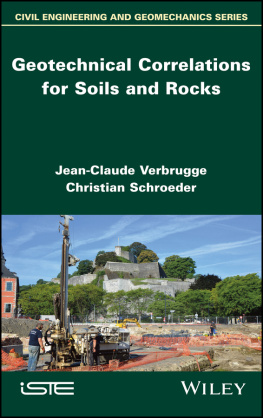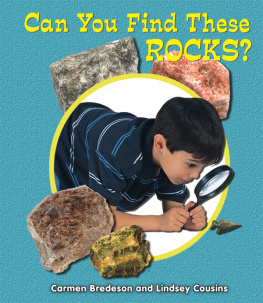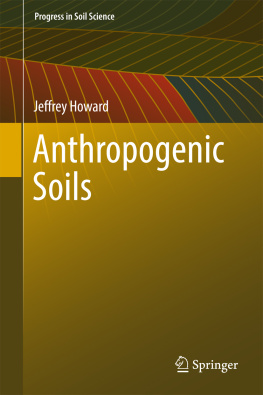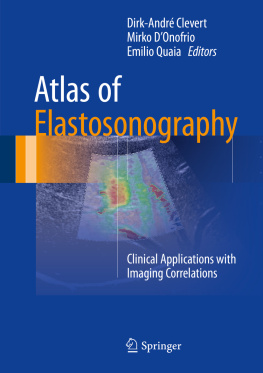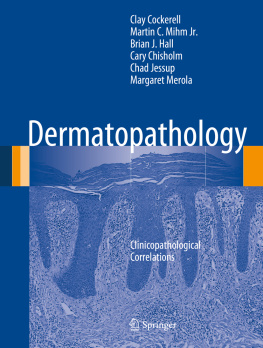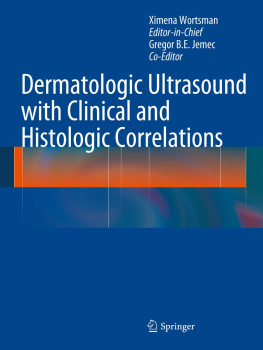
Series Editor
Gilles Pijaudier-Cabot
Geotechnical Correlations for Soils and Rocks
Jean-Claude Verbrugge
Christian Schroeder
First published 2018 in Great Britain and the United States by ISTE Ltd and John Wiley & Sons, Inc.
Apart from any fair dealing for the purposes of research or private study, or criticism or review, as permitted under the Copyright, Designs and Patents Act 1988, this publication may only be reproduced, stored or transmitted, in any form or by any means, with the prior permission in writing of the publishers, or in the case of reprographic reproduction in accordance with the terms and licenses issued by the CLA. Enquiries concerning reproduction outside these terms should be sent to the publishers at the undermentioned address:
ISTE Ltd
27-37 St Georges Road
London SW19 4EU
UK
www.iste.co.uk
John Wiley & Sons, Inc.
111 River Street
Hoboken, NJ 07030
USA
www.wiley.com
ISTE Ltd 2018
The rights of Jean-Claude Verbrugge and Christian Schroeder to be identified as the authors of this work have been asserted by them in accordance with the Copyright, Designs and Patents Act 1988.
Library of Congress Control Number: 2018936398
British Library Cataloguing-in-Publication Data
A CIP record for this book is available from the British Library
ISBN 978-1-78630-279-3
Acknowledgements
The authors wish to express their special thanks to Jean G. Ronsmans, an old friend and a retired consulting engineer, for his detailed review of the manuscript and numerous helpful suggestions.
Many thanks also to Vincent Fiquet, CEO of OREX, and to Yves Rammer and Bernard Espion, our colleagues at the Universit Libre de Bruxelles, for their comments and encouragement in this work.
The documentation received from Nicolas Charue, Director of GeoCoS, and the photographs from Pierre Van Miergroet, Chief of the In-situ Testing Department of OREX, are much appreciated and useful.
Last but not least, the interest expressed by some practitioners and former students has been a precious contribution to sustaining our motivation.
Well-directed criticism and suggestions from the reader are most welcome to help improve the next edition.
The authors of this publication have taken every possible care while preparing this book. However, they cannot guarantee that this book is complete and free of faults. The use of any data or equation from this book is entirely at the readers own risk. It is assumed that the reader is a competent professional in the concerned domain or has acquired the assistance of an expert. The authors hereby exclude any and all liability for any and all damage which may result from the use of the equations and the data from this book.
The cover image depicts tests for the foundations of a parking lot at the junction of the rivers Sambre and Meuse at Namur. In the background is the citadel fortified by Vauban at the end of the 17th Century. Image copyright Pierre van Miergroet (OREX).
Preface
There is a vast difference between a structural engineer and a geotechnical engineer in terms of the material being used. A structural engineer defines the properties of the concerned material, such as concrete or steel, and carries out only a limited number of control tests according to the required standards. In contrast, the material used by a geotechnical engineer is natural and thus, by definition, it can be spatially heterogeneous and, in composition, it can be multiphasic, discontinuous or even anisotropic. This leaves the geotechnical engineer with no choice but to accept it as it is and to accommodate themselves to it. Moreover, while developments in numerical modeling depend increasingly on specific advanced test parameters, soil testing programs remain limited because of the competition between contractors to reduce costs and time.
Consequently, geotechnical survey programs are mainly based on commonly used tests that give basic parameters but not necessarily the required ones. To bridge this gap, designers ought to use correlations. The aim of this book is to help these designers in this critical operation; therefore, because the reader is considered a skilled geotechnician, no theoretical aspects are considered here. It must also be emphasized that correlations can never be a substitute for an adequate investigation or a field- or laboratory-testing program. This is particularly important for rocks whose characteristics depend significantly on their discontinuities. As a result, correlations between properties are few and not obvious and must be interpreted with caution. For rocks, the emphasis will be placed on geological aspects in order to be taken into account in the establishment of correlations. For both soils and rocks, correlations result from test programs on defined areas, either local or large, so they must be considered as site specific. It must also be emphasized that the tests on which they are based have been performed by skilled practitioners and in full compliance with the standards and the state of the art.
Given the above fact, it is well known that parameter measurements in the laboratory will differ from those obtained from field observations or in situ tests. Some of the common reasons for this are listed as follows:
- sampling technique;
- difference in sample orientation and anisotropy;
- effect of sample size due to some discontinuities;
- rate of testing;
- softening or decompression by the removal of load due to excavation;
- degree of saturation.
Coefficients of variation for geotechnical parameters according to [DUN 00]
| Measured or interpreted parameter value | Symbol | Coefficient of variation (V) |
| Unit weight | 37% |
| Buoyant unit weight | 010% |
| Effective friction angle | 213% |
| Undrained shear strength | su | 1340% |
| Undrained strength ratio | su/v | 515% |
| Compression index | Cc | 1037% |
| Preconsolidation stress | p | 1035% |
| Hydraulic conductivity of saturated clay | k | 6890% |
| Hydraulic conductivity of partly saturated clay | k | 130240% |
| Coefficient of consolidation | cv | 3368% |
| Standard penetration blow count | N | 1545% |
| Electric cone penetration test | qc | 515% |
| Mechanical cone penetration test | qc | 1537% |
| Vane shear undrained strength | suVST | 1020% |
| Dilatometer tip resistance | q0 | 515% |
Correlations amplify some scatter that is largely inherent in experimental test results. Duncan [DUN 00] compiled a wide range of coefficients of variation (V) for geotechnical parameters proposed by different authors, which are presented in . The coefficients of variation for which sampling and testing conditions have not been specified must be considered as a rough estimation.
The reader also has to keep in mind the words of Rankine [RAN 62] in his Manual of Civil Engineering: The properties of earth with respect to adhesion and friction are so variable, that the engineer should never trust to tables or to information obtained from books to guide him in designing earthworks, when he has it in his power to obtain the necessary data either by observation of existing earthworks in the same stratum or by experiment.
Next page
